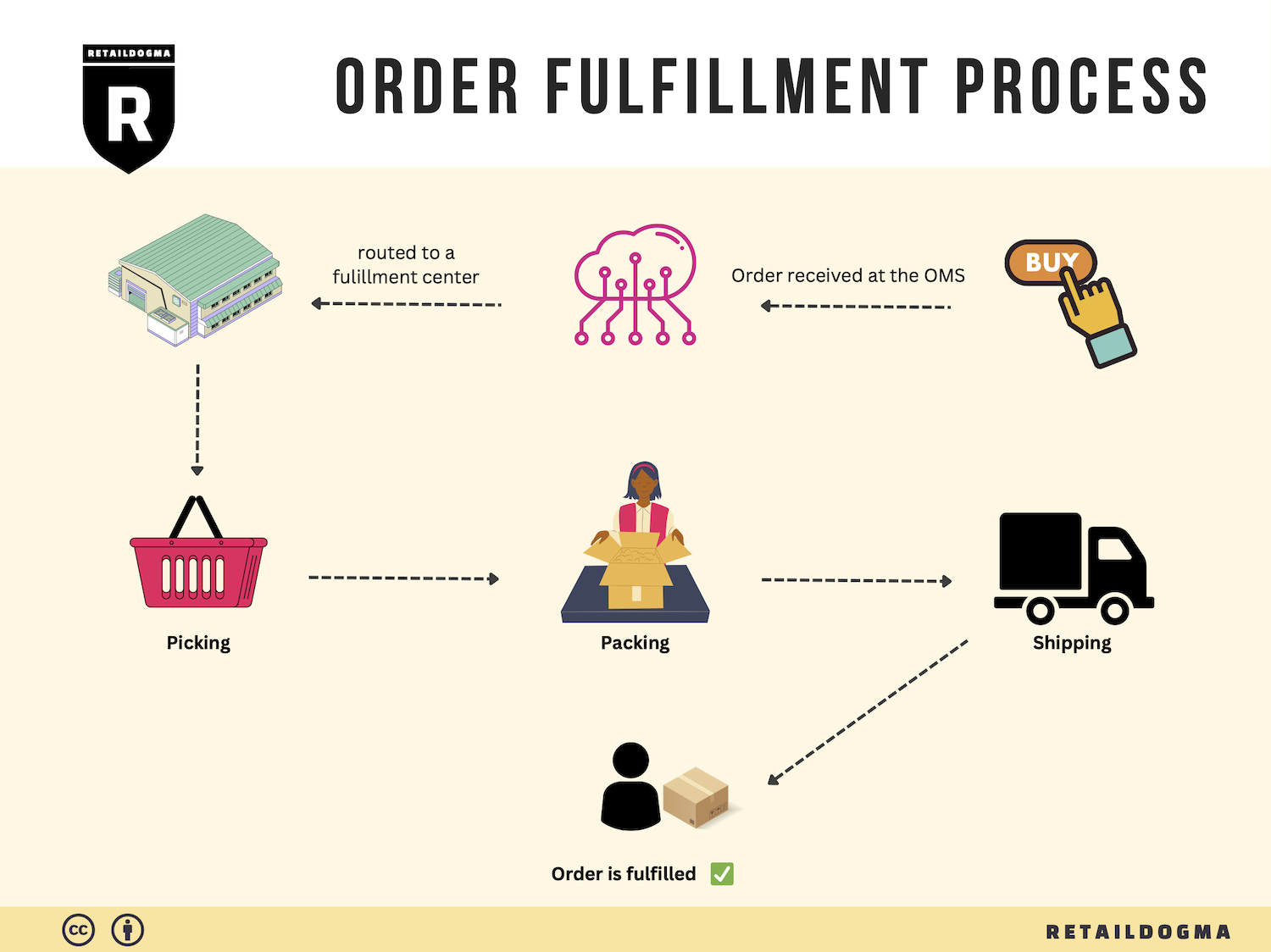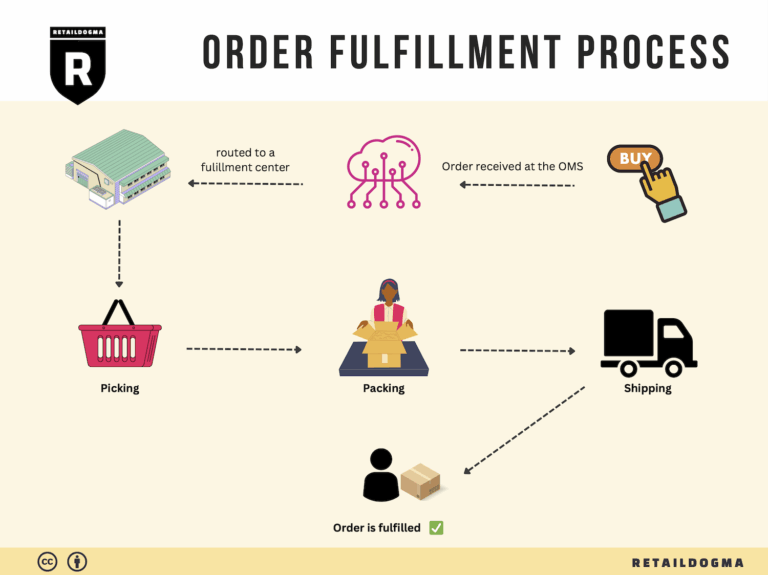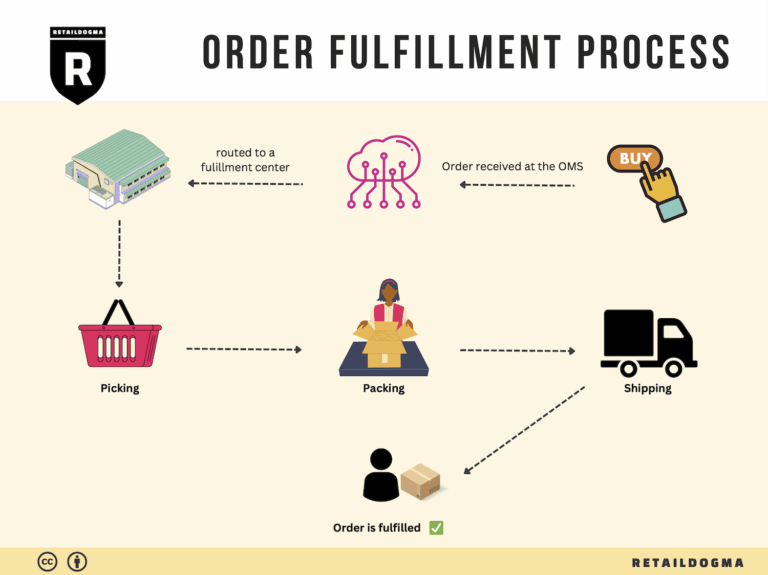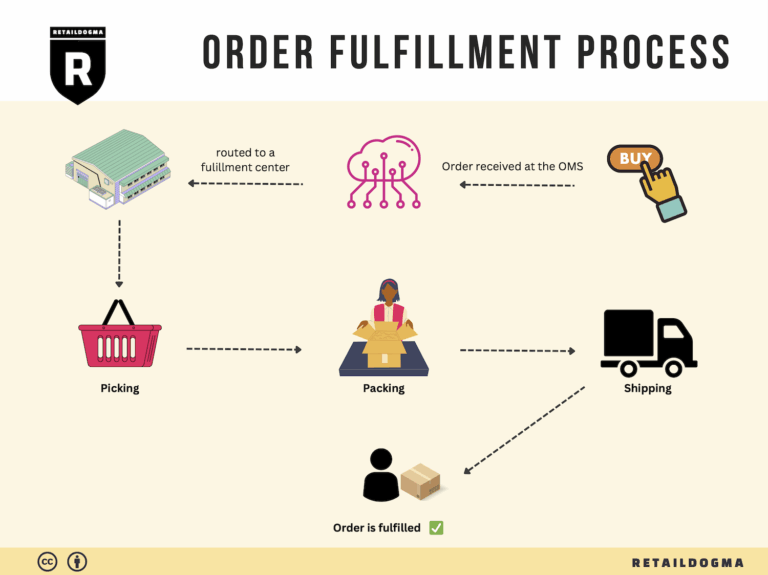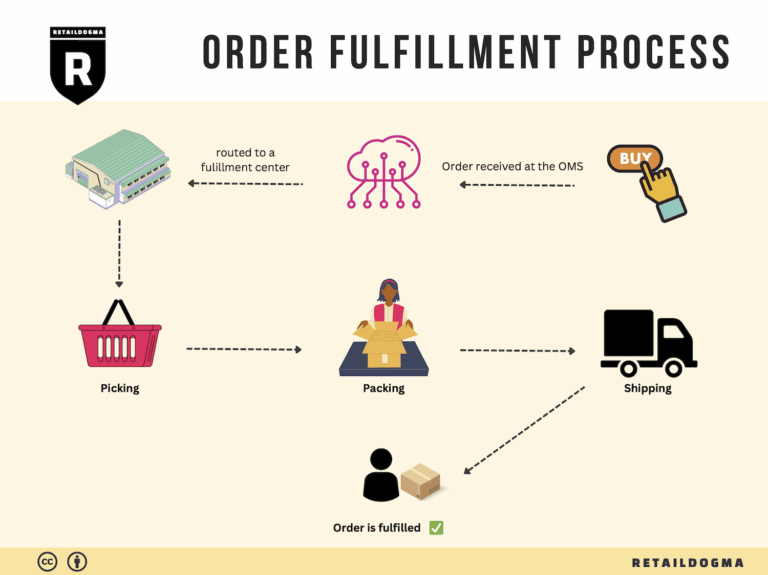What Is A Fulfillment Center? A Complete Guide (2025)
What is E-commerce Fulfillment? An Introduction for Growing Businesses
Growing an e-commerce business can be an exhilarating journey, but it often comes with a set of challenges, particularly when it comes to packing and shipping orders. As your sales increase, so does the complexity of fulfilling those orders efficiently. Many business owners find themselves overwhelmed by the logistics of getting products from their warehouses to their customers’ doorsteps. This is where effective e-commerce fulfillment becomes crucial.
Understanding E-commerce Fulfillment
At its core, e-commerce fulfillment is the process of receiving, processing, and delivering orders to customers. It encompasses everything from inventory management and order processing to packaging and shipping. A streamlined fulfillment process not only enhances customer satisfaction but also enables businesses to scale without sacrificing quality or efficiency. As online shopping continues to grow, having a robust fulfillment strategy can be the difference between success and stagnation.
What This Guide Covers
This guide is designed to help you navigate the complexities of e-commerce fulfillment, providing you with the insights necessary to make informed decisions as you scale your operations. We will explore various fulfillment models, including Third-Party Logistics (3PL) and Fulfillment by Amazon (FBA), highlighting their advantages and potential drawbacks.
You will learn about core fulfillment services essential for smooth operations, such as order receiving, inventory management, warehousing, and shipping. Additionally, we will discuss key factors to consider when choosing a fulfillment partner, including technology integration, service reliability, and customer support.
Pricing is another critical aspect we will address. Understanding the costs associated with different fulfillment models will empower you to choose the best option for your business’s financial health.
Empowering Your Business Decisions
The ultimate goal of this guide is to empower you to make smart decisions regarding your logistics strategy. By understanding the intricacies of e-commerce fulfillment, you can optimize your operations, improve your customer experience, and ultimately drive growth. Whether you are just starting or looking to refine your existing processes, the insights shared here will provide you with the knowledge needed to take your e-commerce business to the next level.
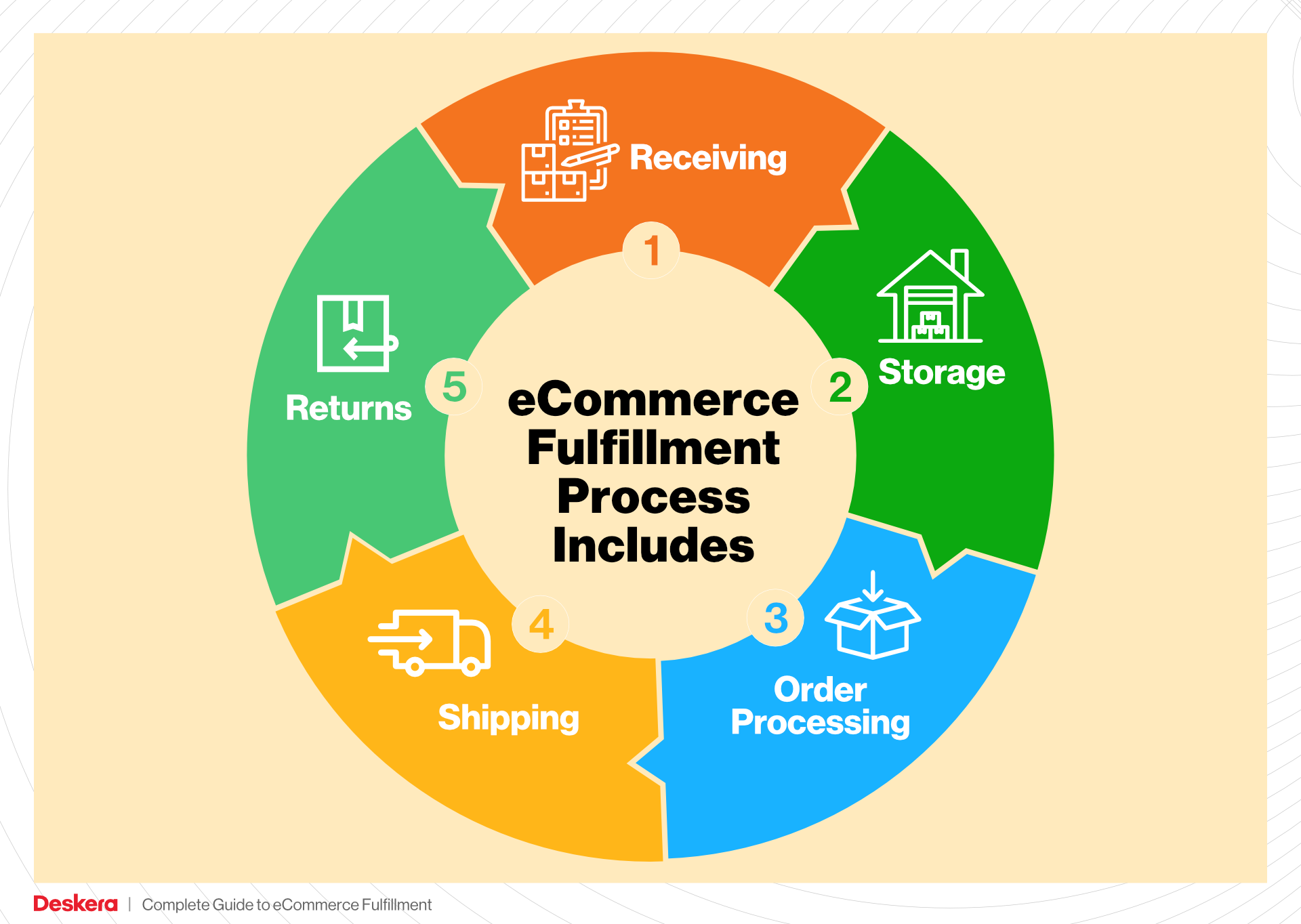
What You’ll Learn In This Guide
- What is E-commerce Fulfillment? An Introduction for Growing Businesses
- The Order Fulfillment Process: From ‘Buy’ Button to Customer’s Door
- Comparing Fulfillment Models: In-House vs. 3PL vs. Dropshipping
- A Deep Dive into Amazon FBA: Pros, Cons, and Who It’s For
- Core Services Offered by Fulfillment Centers
- How to Choose a Fulfillment Partner: A 6-Point Checklist
- Understanding Fulfillment Pricing: A Breakdown of Common Fees
- Frequently Asked Questions (FAQs) about Fulfillment
- Conclusion: Is Outsourcing Fulfillment the Right Move for Your Business?
- Important Disclaimer
The Order Fulfillment Process: From ‘Buy’ Button to Customer’s Door
1. Receiving Inventory
The order fulfillment process begins with the receiving of inventory, a critical step that sets the foundation for an efficient operation. When products arrive at the fulfillment center, they are scanned using a Universal Product Code (UPC) system to ensure accuracy. This process involves reconciling the received inventory against the expected quantities, allowing for the identification of discrepancies immediately.
Why is this important? Accurate receiving minimizes errors that can lead to stock shortages or overages, both of which can disrupt the fulfillment process. A reliable inventory receiving system helps maintain an accurate count of available products, which is essential for effective inventory management and planning. By ensuring that all items are accounted for upon arrival, businesses can enhance their operational efficiency and customer satisfaction.
2. Warehouse Storage
Once inventory has been received and verified, the next step is warehouse storage. Efficient storage strategies are vital for maximizing warehouse space and ensuring that products can be accessed quickly when orders are placed. Products are organized based on a system that may include FIFO (First In, First Out) or LIFO (Last In, First Out) methodologies, depending on the type of goods being stored.
The importance of effective warehouse storage cannot be overstated. A well-organized storage system reduces the time spent locating products, thus streamlining the picking process. Additionally, employing advanced inventory management software can facilitate real-time tracking of stock levels, which helps businesses maintain optimal inventory levels and avoid stockouts. This proactive approach to inventory management is crucial for scaling operations, as it allows for quick adjustments based on demand fluctuations.
3. Order Picking
With inventory stored efficiently, the next step is order picking. This stage involves selecting the right products from the warehouse to fulfill customer orders. A pick list, which outlines the items and quantities needed for each order, is generated and used by warehouse staff to ensure accuracy and efficiency during the picking process.
Effective order picking is essential for maintaining high order accuracy and customer satisfaction. Errors during this stage can lead to incorrect shipments, which can harm customer trust and lead to costly returns. Utilizing technology, such as barcode scanners or pick-to-light systems, can significantly enhance picking accuracy and speed. By optimizing this process, businesses can ensure that orders are fulfilled quickly and accurately, thereby improving overall customer experience and loyalty.
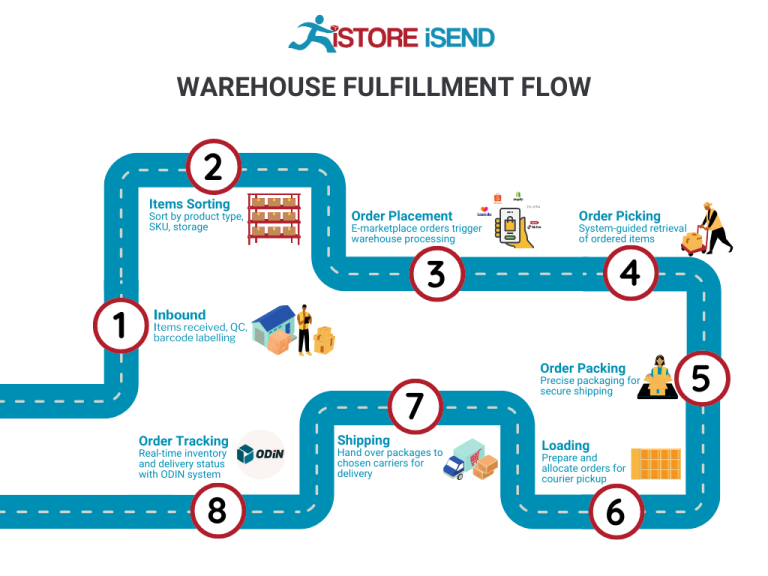
4. Order Packing
After products have been picked, the next step is order packing. This involves carefully packaging the selected items to ensure they arrive at the customer’s doorstep in pristine condition. During this stage, packing materials are chosen based on the type and fragility of the products, with an emphasis on minimizing damage during transit.
The significance of proper packing cannot be overstated. Well-packed orders not only protect the products but also enhance the unboxing experience for customers, which can lead to positive brand impressions. Additionally, integrating packing stations with inventory management systems can streamline the process, allowing for real-time updates on inventory levels. This integration ensures that businesses can manage stock effectively while providing a seamless packing experience.
5. Shipping & Delivery
The final step in the order fulfillment process is shipping and delivery. Once orders are packed, they are labeled and prepared for shipment. This involves selecting the most efficient shipping method based on factors such as cost, speed, and destination. Advanced shipping software can help businesses compare rates from various carriers, ensuring that they choose the best option for each order.
The importance of efficient shipping and delivery lies in its direct impact on customer satisfaction. Timely deliveries contribute to a positive shopping experience, encouraging repeat business and fostering customer loyalty. Moreover, integrating tracking capabilities allows customers to monitor their orders in real time, providing transparency and reducing anxiety about the delivery process. By prioritizing effective shipping strategies, businesses can enhance their overall fulfillment efficiency and customer relationships.
In summary, the order fulfillment process is a multi-step journey that requires careful coordination and management. By mastering each stage—from receiving inventory to shipping and delivery—e-commerce businesses can scale operations, improve customer satisfaction, and ultimately drive growth.
Comparing Fulfillment Models: In-House vs. 3PL vs. Dropshipping
Fulfillment Models Comparison
| Model | Who Handles Inventory | Best For (Business Stage) | Key Advantage | Key Disadvantage |
|---|---|---|---|---|
| In-House Fulfillment | Business Owner/Team | Startups to Established | Full control over operations | High overhead costs and resource demands |
| Third-Party Logistics (3PL) | 3PL Provider | Growing to Established | Scalable and cost-effective solutions | Less control over inventory and processes |
| Dropshipping | Supplier/Vendor | Startups to Small Businesses | Low startup costs and minimal risk | Lower profit margins and potential delays |
In-House Fulfillment
In-house fulfillment involves managing the entire inventory and order processing within the business itself. This model is often favored by startups and established companies that desire direct control over their operations. One of the significant advantages of in-house fulfillment is the ability to maintain a high level of quality control, as businesses can oversee every step of the process, from receiving inventory to packing and shipping orders. This direct oversight can lead to improved customer satisfaction, as businesses can tailor their fulfillment processes to meet specific customer needs and expectations. However, the in-house model also comes with considerable downsides. The overhead costs can be significant, including warehousing, staffing, and technology investments. Additionally, as order volumes increase, the complexity of managing fulfillment can overwhelm smaller teams, leading to inefficiencies and potential service disruptions. Therefore, while in-house fulfillment may be suitable for businesses in their early stages or those with specialized products, it can become burdensome as the company scales.
Third-Party Logistics (3PL)
Third-party logistics (3PL) providers offer businesses a way to outsource their fulfillment needs. In this model, a dedicated 3PL company handles inventory storage, order processing, and shipping on behalf of the e-commerce business. This approach is particularly beneficial for companies that are experiencing growth or are looking to scale without the heavy investment in physical infrastructure and staffing. The key advantage of using a 3PL is scalability; businesses can easily adjust their fulfillment capabilities based on fluctuating order volumes without the need for significant capital outlay. Furthermore, 3PL providers often come equipped with advanced technology, offering real-time inventory management and integration with various e-commerce platforms, which enhances operational efficiency. However, the trade-off is that businesses relinquish some control over their inventory and fulfillment processes. This can lead to challenges, particularly if the 3PL provider does not meet the business’s standards for quality or timeliness. Therefore, selecting the right 3PL partner is crucial, as the success of this model heavily relies on the provider’s reliability and service quality.
Dropshipping
Dropshipping is a fulfillment model where the retailer does not hold inventory but instead transfers customer orders directly to a supplier or manufacturer, who then ships the products directly to the customer. This model is particularly attractive to startups and small businesses due to its low startup costs and minimal financial risk. Since there is no need to invest in inventory upfront, entrepreneurs can launch their e-commerce businesses with significantly less capital. Additionally, dropshipping allows for a wide variety of products to be offered without the burden of maintaining stock, making it a flexible option for testing new markets or product lines. However, dropshipping also presents challenges that can affect profitability and customer satisfaction. The most notable downside is the lower profit margins typically associated with dropshipping, as suppliers often charge higher wholesale prices. Moreover, businesses have limited control over product quality, shipping times, and inventory management, which can lead to customer dissatisfaction if issues arise. As a result, while dropshipping can be an accessible entry point into e-commerce, it requires careful management of supplier relationships and customer expectations to be successful.
In summary, each fulfillment model—In-House, 3PL, and Dropshipping—offers unique advantages and challenges that can significantly impact an e-commerce business’s growth trajectory. Understanding the specific needs of your business and aligning them with the appropriate fulfillment strategy is essential for sustainable scaling.
A Deep Dive into Amazon FBA: Pros, Cons, and Who It’s For
Understanding Fulfillment by Amazon (FBA)
Fulfillment by Amazon (FBA) is a service provided by Amazon that enables sellers to store their products in Amazon’s fulfillment centers. Amazon then takes care of storage, packaging, shipping, and customer service for these products. This service allows sellers to leverage Amazon’s vast logistics network and customer base while focusing on other aspects of their business, such as marketing and product development.
How FBA Works
-
Set Up Your FBA Account: To begin using FBA, sellers must create an Amazon seller account and opt for the FBA service. This involves selecting the products they want to fulfill through Amazon and configuring their listings accordingly.
-
Prepare Your Products: Sellers are responsible for preparing their products according to Amazon’s specific requirements, which include labeling, packaging, and ensuring the products meet Amazon’s quality standards.
-
Ship Products to Amazon: Once the products are prepared, sellers ship them to Amazon’s fulfillment centers. Depending on the seller’s location and the products’ categories, Amazon may direct them to different warehouses.
-
Storage and Inventory Management: After the products arrive at the fulfillment center, Amazon manages the inventory. Sellers can monitor their inventory levels in real time through the Amazon Seller Central dashboard.

-
Order Processing: When a customer places an order for a product fulfilled by FBA, Amazon handles the entire order processing. This includes picking the product from the warehouse, packing it, and shipping it to the customer.
-
Customer Service and Returns: Amazon provides customer service for FBA orders, handling inquiries, and managing returns on behalf of the seller, which can significantly reduce the operational burden on small businesses.
Pros of Fulfillment by Amazon (FBA)
-
Prime Eligibility: One of the most significant advantages of FBA is that products become eligible for Amazon Prime. This means that millions of Prime members can purchase products with the benefit of free two-day shipping, increasing the likelihood of sales.
-
Customer Trust: Amazon is a trusted platform with a well-established reputation. When customers see that a product is fulfilled by Amazon, they often feel more confident in their purchase, leading to higher conversion rates for sellers.
-
Multi-Channel Fulfillment: FBA allows sellers to fulfill orders not only from Amazon but also from other sales channels. This means that if a seller has their own website or sells on platforms like eBay or Shopify, they can still use Amazon’s fulfillment services to handle those orders, streamlining logistics.
-
Scalability: FBA provides a scalable solution for sellers looking to grow their business. As sales increase, Amazon’s infrastructure can handle the logistics without requiring sellers to invest heavily in their own warehousing and shipping capabilities.
-
Automated Returns Management: Amazon’s efficient returns process simplifies the often cumbersome task of managing returns for sellers, leading to better customer satisfaction and less hassle.
Cons of Fulfillment by Amazon (FBA)
-
High Fees: While FBA offers numerous benefits, it comes with a range of fees, including storage fees for products stored in Amazon’s warehouses and fulfillment fees for each order processed. These costs can add up quickly, particularly for sellers with low margins.
-
Strict Inventory Rules: Amazon has stringent guidelines regarding inventory management. Sellers must adhere to these rules or risk penalties, including the possibility of their inventory being returned or disposed of.
-
Commingling Risks: Amazon often commingles inventory from different sellers to streamline fulfillment. This means that sellers’ products may be shipped alongside those of other sellers, which can lead to issues if a customer receives the wrong item or if there are quality control problems.
-
Limited Control Over Branding: When using FBA, sellers have limited control over the packaging and branding of their products. Amazon’s standardized packaging can dilute a seller’s brand identity and customer experience.
-
Potential for Stockouts: If a seller’s inventory runs low, it can lead to stockouts, which can impact sales and visibility on Amazon’s platform. Maintaining adequate inventory levels is crucial but can be challenging, especially for fast-selling items.
Who is FBA Best For?
Fulfillment by Amazon is particularly well-suited for certain types of e-commerce businesses:
-
Small to Medium-Sized Sellers: Those without the resources to manage their own warehousing and logistics can benefit immensely from FBA, as it allows them to focus on growing their business rather than getting bogged down in fulfillment.
-
Sellers with High Sales Volume: Businesses that anticipate high sales volumes can take advantage of FBA’s scalability and efficiency, maximizing their reach without needing to invest heavily in logistics infrastructure.
-
Brands Seeking Prime Status: Sellers looking to increase their product visibility and appeal to the Prime member demographic will find FBA particularly beneficial due to the Prime eligibility it offers.
-
Multi-Channel Sellers: Businesses that sell on multiple platforms and want a streamlined logistics solution will appreciate FBA’s ability to handle orders from various channels.
In conclusion, Fulfillment by Amazon offers a powerful solution for sellers looking to leverage Amazon’s infrastructure for their logistics needs. However, it’s essential to weigh the pros and cons carefully to determine whether FBA aligns with your business model and growth strategy.
Core Services Offered by Fulfillment Centers
Inventory Management & Warehousing
Efficient inventory management and warehousing are fundamental components of any successful fulfillment operation. This service involves the systematic storage and tracking of products within a fulfillment center. Advanced software systems enable real-time updates on inventory levels, providing e-commerce businesses with insights into stock availability, back orders, and incoming shipments.
The primary benefit of robust inventory management is the reduction of stockouts and overstock situations. By maintaining optimal inventory levels, businesses can ensure they meet customer demand without tying up excessive capital in unsold goods. Additionally, accurate inventory data allows for better forecasting and planning, enabling businesses to make informed decisions about purchasing and marketing strategies. Ultimately, effective inventory management leads to improved customer satisfaction, as orders can be fulfilled promptly and accurately.
Pick and Pack Services
Pick and pack services represent the heart of the order fulfillment process. This service entails the selection of items from warehouse shelves (picking) and packaging them for shipment (packing). Fulfillment centers utilize sophisticated software to streamline these processes, often employing batch picking and optimized routing to increase efficiency. Each order is meticulously checked to ensure accuracy before it leaves the warehouse.
For e-commerce businesses, the benefits of pick and pack services are manifold. First and foremost, they significantly reduce the time it takes to fulfill orders, which is crucial for meeting customer expectations in today’s fast-paced market. Furthermore, high accuracy rates in picking and packing minimize the risk of errors, which can lead to costly returns and dissatisfied customers. By outsourcing these services, e-commerce businesses can focus their resources on growth and customer engagement, confident that their fulfillment processes are in capable hands.
Kitting and Assembly
Kitting and assembly services involve grouping individual items into a single package or creating product bundles that are ready for sale. This can include assembling components into a final product or simply packaging multiple items together as a kit. Fulfillment centers often handle this process in anticipation of demand, allowing businesses to offer ready-to-ship products without delays.
The primary advantage of kitting and assembly is the enhancement of product offerings and customer satisfaction. By providing bundled products, e-commerce businesses can increase perceived value and encourage higher sales volumes. Additionally, pre-assembled kits streamline the order fulfillment process, reducing the time from order placement to delivery. This proactive approach not only enhances operational efficiency but also boosts customer loyalty, as customers appreciate receiving their orders without unnecessary wait times.
Returns Management (Reverse Logistics)
Returns management, or reverse logistics, is an essential service that addresses the complexities of product returns. This involves processing returned items, restocking them, and updating inventory levels accordingly. A well-structured returns management system ensures that the return process is smooth for both customers and businesses.
For e-commerce businesses, effective returns management is crucial for maintaining customer trust and satisfaction. A hassle-free return process can enhance customer loyalty, as shoppers are more likely to make a purchase if they know they can return it easily. Additionally, analyzing return data can provide valuable insights into product quality and customer preferences, helping businesses make informed decisions about inventory and product offerings. In a competitive landscape, having a robust returns management system can be a key differentiator, transforming potential customer dissatisfaction into opportunities for engagement and retention.
In conclusion, fulfillment centers offer a suite of core services that are integral to the success of e-commerce businesses. By leveraging these services—inventory management and warehousing, pick and pack, kitting and assembly, and returns management—businesses can enhance their operational efficiency, improve customer satisfaction, and ultimately scale their operations effectively. Understanding and utilizing these services allows e-commerce entrepreneurs to focus on strategic growth while leaving the complexities of logistics to experienced fulfillment partners.
How to Choose a Fulfillment Partner: A 6-Point Checklist
Location & Warehouse Network
Choosing a fulfillment partner with a strategically located warehouse network is crucial for ensuring timely delivery and minimizing shipping costs. The proximity of warehouses to your target customer base can significantly impact shipping speed and overall customer satisfaction.
Questions to Ask:
– Where are your warehouses located, and how do they align with our customer demographics?
– Do you have multiple warehouse locations to facilitate faster shipping across different regions?
– What is your average shipping time to major markets?
Technology & Integrations
In today’s e-commerce landscape, seamless integration between your e-commerce platform and your fulfillment partner’s systems is essential. Advanced technology can streamline operations, provide real-time inventory updates, and facilitate accurate order tracking.
Questions to Ask:
– What inventory management software do you use, and how does it integrate with popular e-commerce platforms like Shopify, WooCommerce, and Amazon?
– Can you provide real-time inventory updates, and how do you handle inventory discrepancies?
– Do you support API or EDI integrations for custom solutions?
Specializations (e.g., Cold Storage, Oversized Items)
Depending on your product type, you may require a fulfillment partner with specialized services. If you sell perishable goods, for example, cold storage capabilities are essential. Similarly, if you deal with oversized items, ensure your partner has the capacity and expertise to handle such products.
Questions to Ask:
– What types of specialized fulfillment services do you offer (e.g., cold storage, kitting, assembly)?
– How do you manage the unique requirements for handling different types of products?
– Can you provide case studies or examples of how you’ve successfully fulfilled specialized orders?
Scalability & Capacity
As your business grows, your fulfillment needs will change. It’s essential to partner with a fulfillment provider that can scale operations alongside your growth. A good partner should have the capacity to manage increased order volumes without sacrificing service quality.
Questions to Ask:
– How do you handle peak seasons or unexpected surges in order volume?
– What is your current capacity, and how do you plan to scale in the future?
– Can you share examples of how you’ve supported clients during their growth phases?
Pricing and Contracts
Understanding the pricing structure of your fulfillment partner is critical for budgeting and financial planning. Transparent pricing can help you avoid unexpected fees and understand how costs may change as your business scales.
Questions to Ask:
– What is your pricing model (e.g., per order, per item, storage fees)?
– Are there any hidden fees (e.g., for returns, kitting, or special handling)?
– What are the terms of your contract, and is there flexibility for renegotiation as our business needs evolve?
Customer Support & Reviews
Effective customer support can make or break your partnership with a fulfillment provider. A responsive support team can help resolve issues quickly, ensuring a smooth operation. Additionally, reviews and testimonials from other clients can provide insight into the partner’s reliability and service quality.
Questions to Ask:
– What support options do you offer (e.g., dedicated account manager, 24/7 support)?
– How do you handle customer service issues that arise during the fulfillment process?
– Can you provide references or case studies from similar businesses in our industry?
Conclusion
Choosing the right fulfillment partner is a pivotal decision for your e-commerce business. By carefully considering these six key areas—Location & Warehouse Network, Technology & Integrations, Specializations, Scalability & Capacity, Pricing and Contracts, and Customer Support & Reviews—you can ensure that you select a partner that not only meets your current needs but also supports your future growth. Asking the right questions will help you make an informed decision and pave the way for a successful and efficient fulfillment operation.
Understanding Fulfillment Pricing: A Breakdown of Common Fees
Initial Setup Fees
Initial setup fees are often a one-time charge that covers the costs associated with onboarding your business into a fulfillment center. This may include creating your account, integrating your e-commerce platform with the fulfillment software, and establishing inventory management protocols. Depending on the complexity of your operations, these fees can vary significantly.
Businesses that require extensive customization or have multiple sales channels may incur higher setup costs due to the additional time and resources needed for integration. To get a clearer picture, ask potential fulfillment partners for a detailed breakdown of what their setup fees cover, and ensure that they align with your specific operational needs.
Receiving Fees
Receiving fees are charged for the process of accepting and logging your inventory into the fulfillment center. This includes unloading shipments, inspecting products for quality, and entering items into the inventory management system.
Typically, receiving fees are calculated per pallet or per unit. For example, if you send a shipment containing 10 pallets, you may be charged a flat fee for each pallet received. Understanding how these fees are structured is crucial, as they can add up quickly, especially for businesses with high inventory turnover or frequent shipments.
Storage Fees (per pallet/bin)
Storage fees are recurring charges for keeping your inventory within the fulfillment center. These fees can be calculated on a per pallet or per bin basis, depending on how the fulfillment center organizes its warehouse.
Storage costs can vary significantly based on the size of your inventory and the duration it remains in the warehouse. Some fulfillment centers may offer tiered pricing, where the cost per pallet decreases as you store more pallets. Additionally, it’s essential to consider any potential additional charges for long-term storage, which may apply if your inventory remains unsold for an extended period.
To manage storage costs effectively, businesses should regularly analyze their inventory turnover rates and adjust their stock levels accordingly. This proactive approach can help avoid unnecessary storage fees.
Pick & Pack Fees (per item/order)
Pick and pack fees are charged for the labor involved in selecting items from inventory and preparing them for shipment. This fee can be structured in a couple of ways: per item picked or per order processed.
For example, if your order consists of three different items, you might pay a fee for each item picked, or you could be charged a flat rate for the entire order, regardless of the number of items. The method of calculation can significantly impact your overall fulfillment costs, especially if your business frequently ships multi-item orders.
Moreover, it’s essential to inquire about any additional costs associated with special packing requirements, such as custom packaging or kitting services, which may incur extra fees.
Shipping Fees
Shipping fees cover the costs associated with transporting your products to customers. These fees can vary based on factors such as the shipping method (standard, expedited, etc.), the destination, and the weight and dimensions of the package.
Many fulfillment centers offer negotiated shipping rates with carriers, which can be passed on to clients. Understanding how these shipping costs are calculated is vital for forecasting your overall fulfillment expenses. Businesses should explore options for consolidating shipments or using regional fulfillment centers to reduce shipping costs and improve delivery times.
Tips for Getting an Accurate Quote
To ensure you receive an accurate fulfillment quote, consider the following tips:
-
Detail Your Needs: Be clear about your business model, expected order volumes, and inventory turnover rates. The more information you provide, the better the fulfillment partner can tailor their quote.
-
Ask for a Breakdown: Request a detailed breakdown of all fees involved, including any potential additional charges for services like returns management or special handling.
-
Compare Quotes: Don’t settle for the first quote you receive. Compare offers from multiple fulfillment centers to understand the market rate and find a partner that aligns with your budget and service expectations.
-
Discuss Scalability: Ensure that the fulfillment center can accommodate your growth. Ask how fees may change as your order volume increases or if you decide to expand into new markets.
-
Review Contract Terms: Before signing any agreements, review the contract terms thoroughly to avoid unexpected fees or limitations on service levels.
By understanding the common fulfillment pricing models and following these tips, you can make informed decisions that support the growth and efficiency of your e-commerce operations.
Frequently Asked Questions (FAQs) about Fulfillment
1. What is fulfillment in e-commerce?
Fulfillment in e-commerce refers to the entire process of receiving, processing, and delivering orders to customers. This includes receiving inventory, managing stock levels, picking and packing products, shipping orders, and handling returns. Efficient fulfillment is crucial for customer satisfaction and can significantly impact a business’s reputation and sales.
2. What is a 3PL (Third-Party Logistics)?
A 3PL, or third-party logistics provider, is a company that manages logistics and supply chain functions on behalf of another business. This includes warehousing, inventory management, order fulfillment, and shipping. By partnering with a 3PL, businesses can streamline operations, reduce costs, and focus on core activities like marketing and product development.
3. What’s the difference between a warehouse and a fulfillment center?
A warehouse is primarily focused on storing goods, often for long-term inventory holding. In contrast, a fulfillment center is designed specifically for processing orders and shipping products quickly to customers. Fulfillment centers utilize advanced technology and processes to ensure efficient order picking, packing, and shipping, making them essential for e-commerce operations.
4. How much do fulfillment services cost?
The cost of fulfillment services can vary widely based on factors such as order volume, storage space, and specific service requirements (e.g., kitting, assembly, or returns management). Generally, costs are structured around a combination of storage fees, picking and packing fees, and shipping costs. It’s advisable to request a custom quote from a fulfillment provider to get a precise estimate tailored to your business needs.
5. How does Encore Fulfillment integrate with my e-commerce platform?
Encore Fulfillment offers seamless integration with major e-commerce platforms like Shopify, Magento, WooCommerce, and Amazon. This integration allows for real-time inventory updates, order processing, and tracking, ensuring that you maintain accurate stock levels and streamline your fulfillment operations without manual intervention.
6. What are the benefits of using a fulfillment service?
Using a fulfillment service can provide several benefits, including:
– Scalability: Easily scale operations as your business grows.
– Cost Efficiency: Reduce overhead costs associated with warehousing and logistics.
– Expertise: Leverage industry knowledge and technology for optimized operations.
– Faster Shipping: Improve delivery times and customer satisfaction.
– Focus on Core Business: Free up time to concentrate on marketing and product development.
7. How does Encore Fulfillment handle returns?
Encore Fulfillment has a standardized returns management process that streamlines the return of products. This system keeps both you and your customers updated on the status of returns and ensures that inventory adjustments are made promptly. Efficient returns management can enhance customer satisfaction and loyalty.
8. What is real-time inventory management, and why is it important?
Real-time inventory management refers to the ability to track inventory levels and movements as they occur. This feature is essential for preventing stockouts, managing backorders, and maintaining accurate inventory records. With real-time updates, businesses can make informed decisions about reordering and inventory allocation, ultimately enhancing operational efficiency.
9. Can Encore Fulfillment handle international shipping?
Yes, Encore Fulfillment can facilitate international shipping. They work with various carriers and have established processes to ensure compliance with customs regulations, which allows for smooth and efficient delivery of orders to customers around the globe.
10. What are FBA prep services, and how can they benefit my Amazon business?
Fulfillment by Amazon (FBA) prep services involve preparing products according to Amazon’s specific requirements for packaging, labeling, and sorting. By using FBA prep services, businesses can avoid potential issues like account suspensions or returns due to non-compliance. This allows sellers to focus on growing their business while ensuring that their products meet Amazon’s standards for efficient processing and delivery.
Conclusion: Is Outsourcing Fulfillment the Right Move for Your Business?
Evaluating the Benefits of Outsourcing Fulfillment
Outsourcing your fulfillment needs can be a transformative decision for your e-commerce business. By leveraging a dedicated fulfillment partner, you can save significant time and resources, allowing you to focus on core business activities such as marketing, product development, and customer engagement. This efficiency is particularly vital in the fast-paced world of e-commerce, where customer expectations for timely delivery are higher than ever.
Scalability is another key advantage. As your business grows, so do the complexities of managing inventory, shipping logistics, and returns. A fulfillment service provides the flexibility to scale operations seamlessly, accommodating fluctuations in order volume during peak seasons or promotional events without the need for major capital investments in infrastructure or personnel. This adaptability not only supports growth but also enhances your ability to meet customer demand reliably.
Additionally, partnering with a fulfillment expert brings invaluable industry knowledge and operational expertise to the table. These providers utilize advanced technologies and best practices in inventory management, order processing, and shipping logistics, ensuring your customers receive their orders accurately and on time. With a fulfillment partner, you can also access real-time data and analytics to inform strategic decisions and optimize your supply chain.
However, selecting the right fulfillment partner is crucial for achieving these benefits. A misaligned partnership can lead to inefficiencies, increased costs, and ultimately, customer dissatisfaction. Therefore, it’s essential to conduct thorough research and assess potential partners based on their capabilities, technology, and service levels.
Take Action
To determine if outsourcing fulfillment is the right next step for your business, start by auditing your current shipping processes. Identify areas where you are facing challenges or inefficiencies. Assess your growth goals and consider whether a fulfillment partner could help you achieve them more effectively. By taking this proactive approach, you can make a well-informed decision that positions your business for sustainable growth.
Important Disclaimer
⚠️ Important Disclaimer
The information in this guide is for educational purposes. Fulfillment services, pricing, and platform features change frequently. Always conduct your own due diligence and consult with providers directly before making business decisions.
